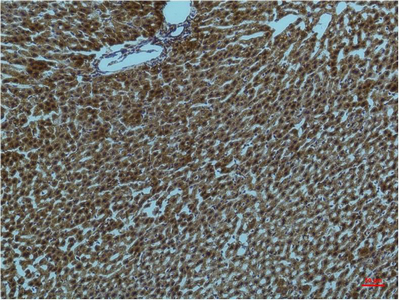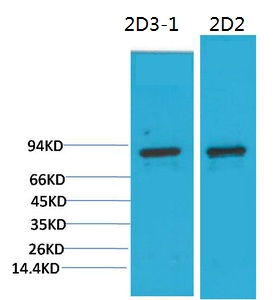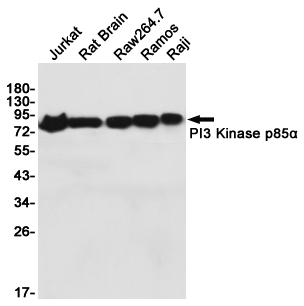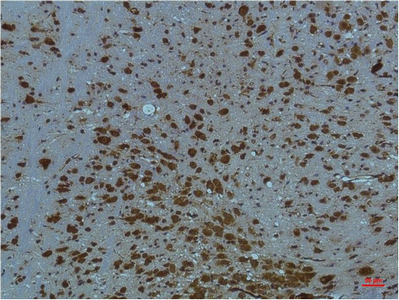-
Product Name
Anti-PI3 Kinase p85 alpha (1C8) Mouse antibody
- Documents
-
Description
PI3 Kinase p85 alpha (1C8) Mouse monoclonal antibody
-
Tested applications
WB, IHC-P
-
Species reactivity
Rat, Mouse
-
Isotype
Mouse IgG1
-
Preparation
Antigen: Purified recombinant protein expressed in E.coli.
-
Clonality
Monoclonal
-
Formulation
PBS(pH 7.4) containing with 0.02% sodium azide and 50% glycerol.
-
Storage instructions
Store at 4°C short term. Store at -20°C long term. Avoid freeze / thaw cycle.
-
Applications
WB: 1/1;000-2;000
IHC: 1/100-200
-
Validations

Immunohistochemical analysis of paraffin-embedded Rat Liver Tissue using PI3 Kinase P85 α Mouse mAb diluted at 1:200.

Western blot analysis of 1)3T3, 2) Rat LiverTissue with PI3 Kinase P85α Mouse mAb diluted at 1:2,000.

Western blot detection of PI3 Kinase p85α in Jurkat,Rat Brain,Raw264.7,Ramos,Raji cell lysates using PI3 Kinase p85α (1C8) Mouse mAb(1:1000 diluted).Predicted band size:85KDa.Observed band size:85KDa.

Immunohistochemical analysis of paraffin-embedded Mouse BrainTissue using PI3 Kinase P85 α Mouse mAb diluted at 1:200.
-
Background
Swiss-Prot Acc.P27986.Binds to activated (phosphorylated) protein-Tyr kinases, through its SH2 domain, and acts as an adapter, mediating the association of the p110 catalytic unit to the plasma membrane. Necessary for the insulin-stimulated increase in glucose uptake and glycogen synthesis in insulin-sensitive tissues. Plays an important role in signaling in response to FGFR1, FGFR2, FGFR3, FGFR4, KITLG/SCF, KIT, PDGFRA and PDGFRB. Likewise, plays a role in ITGB2 signaling (PubMed:17626883, PubMed:19805105, PubMed:7518429). Modulates the cellular response to ER stress by promoting nuclear translocation of XBP1 isoform 2 in a ER stress- and/or insulin-dependent manner during metabolic overloading in the liver and hence plays a role in glucose tolerance improvement (PubMed:20348923).
Related Products / Services
Please note: All products are "FOR RESEARCH USE ONLY AND ARE NOT INTENDED FOR DIAGNOSTIC OR THERAPEUTIC USE"
